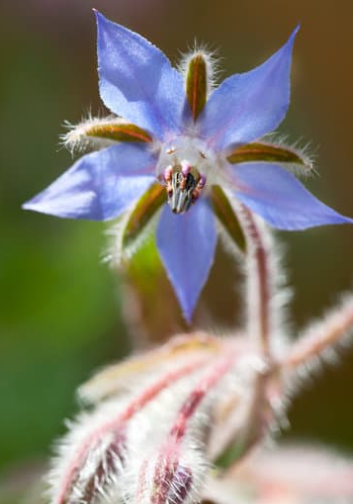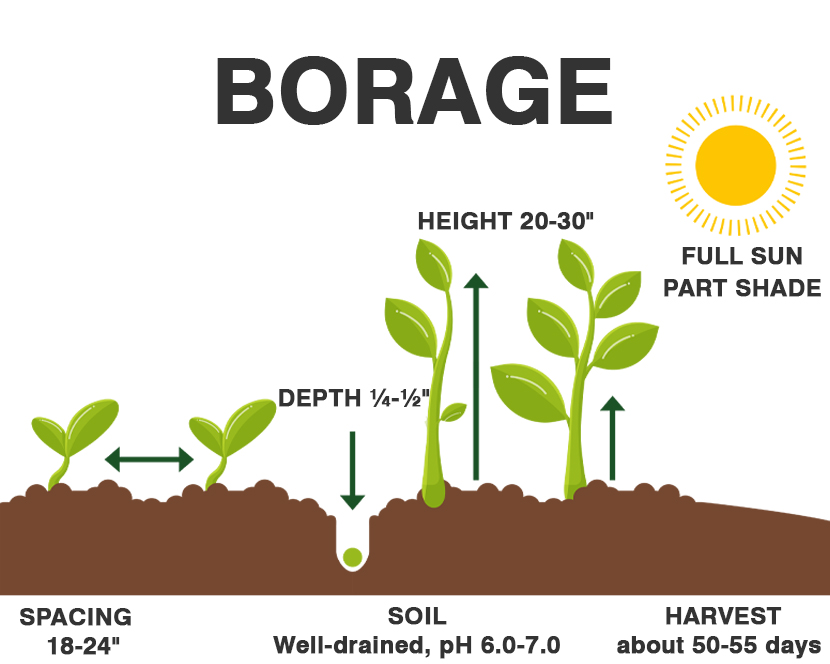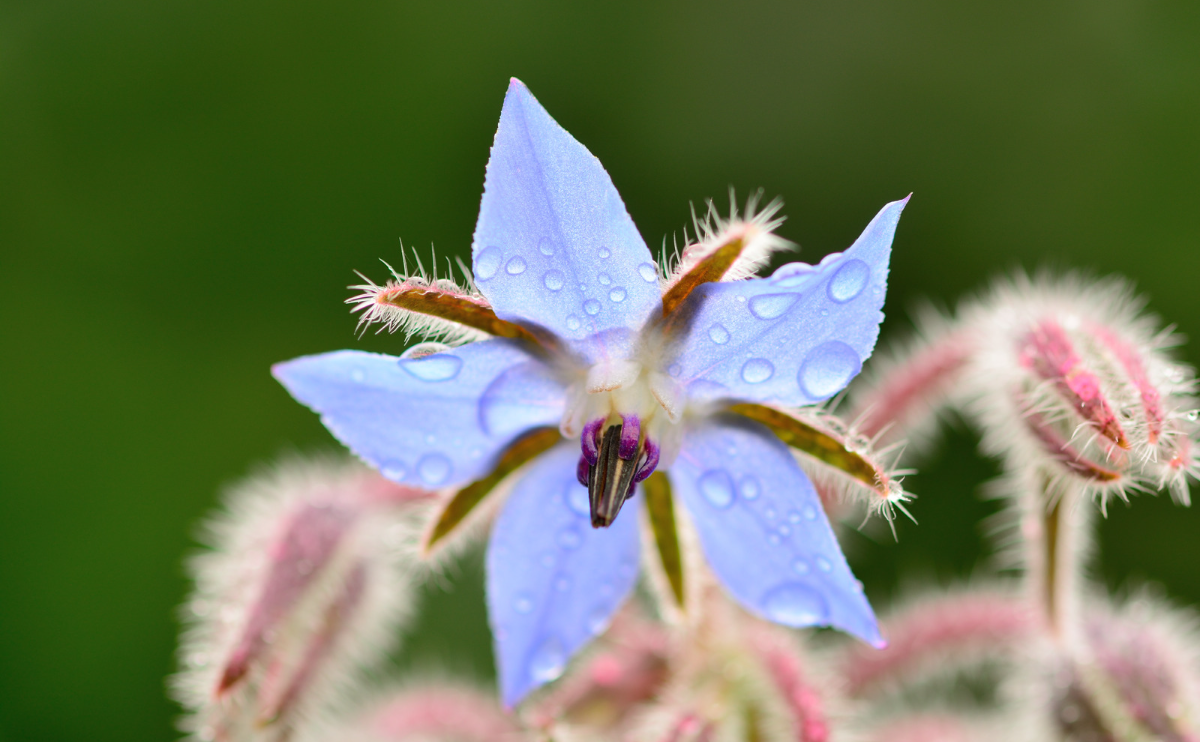Borage is an easy, fast-growing, annual herb with vivid blue flowers and the flavor and scent of cucumbers. While it is considered an herb, it’s often grown as a flowering plant to entice pollinators into vegetable gardens. Borage is considered a good companion plant for tomatoes, squash, and strawberries. It’s even supposed to deter tomato hornworms and improve the flavor of tomatoes growing nearby. Borage is an annual plant, but it self-seeds readily.
Borage is a somewhat gangly plant, but you barely notice that because the star-shaped flowers hanging in downward-facing clusters are so vibrant. It also boasts a greenish-gray stem and leaves that are covered in a prickly fuzz, which acts as a deterrent for insects. Planting borage should be done in the early spring. While people do eat the leaves, technically the leaves are mildly toxic both to people and pets. In raw form, the leaves contain pyrrolizidine alkaloids that can cause a variety of mild but unpleasant digestive problems if eaten in large quantities.

| Common Name | Borage, starflower, tailwort |
| Botanical Name | Borago officinalis |
| Family | Boraginaceae |
| Plant Type | Annual, herb |
| Size | 1-3 ft. tall, 9-18 in. wide |
| Sun Exposure | Full sun, partial sun |
| Soil Type | Well-drained |
| Soil pH | Acidic, neutral, alkaline |
| Bloom Time | Summer |
| Bloom Color | Blue |
| Hardiness Zones | 2–11 (USDA) |
| Native Area | Mediterranean |
| Toxicity | Toxic to people and pets |

When to Plant?
This will be determined by your planting zone. There is a final frost date for each area. As a result, you can plan your gardening activities around this date. Check our Frost Dates Across North America: First & Last Frost Dates Chart. However, the date will not be the same for every plant.
How to Plant
Direct sow in average soil in a sunny or lightly shaded area, after danger of spring frost. Borage is an attractive flowering annual in cottage gardens or borders or planted with herbs and vegetables. Remove weeds and work organic matter into the top 6-8 inches of soil; then level and smooth.
Sow seeds about 12 inches apart and cover with ¼ inch of fine soil. Firm the soil lightly and keep evenly moist. Seedlings emerge in 7-14 days. This gradually stands 18-24 inches apart when seedlings are 1-2 inches high.

Store borage and other herbs in a cool, dark room or cabinet. Heat and direct light cause herbs to lose their flavor more quickly. Use dried borage within three months in order to appreciate it at peak flavor. Harvest leaves and flowers in the early afternoon after the dew on the plant has dried; otherwise, borage is more prone to mildewing during the drying process. Companion plants – tomatoes, cabbage, squash, strawberries. The borage companion plant is said to repel tomato worms and cabbage worms because borage attracts beneficial insects, such as bees and tiny wasps. As we know, these are great plant pollinators, but they also repel garden pests.
How to Cultivate
Keep weeds under control during the growing season. Weeds compete with plants for water, space, and nutrients, so control them by either cultivating often or using a mulch to prevent their seeds from germinating.
Mulches also help retain soil moisture and maintain even soil temperatures. For herbs, an organic mulch of aged bark or shredded leaves lends a natural look to the bed and will improve the soil as it breaks down in time. Always keep mulches off a plant’s stems to prevent possible rot.
Keep plants well-watered during the growing season, especially during dry spells. Plants need about 1 inch of rain per week during the growing season. Use a rain gauge to check to see if you need to add water. It’s best to water with a drip or trickle system that delivers water at low pressure at the soil level. If you water with overhead sprinklers, water early in the day so the foliage has time to dry off before evening, to minimize disease problems. Keep the soil moist but not saturated. Basil should not be allowed to dry out.
How to Harvest
Harvest borage leaves and flowers in the morning, after the dew, has dried but before the intense heat of midday. This will help preserve the oils that give herbs their distinctive flavors.
Pick borage flowers before they are fully open. The flowers are edible and make colorful additions to salads.
Pull the leaves and flowers off with your fingers or clip them with scissors. Discard any brown or withered portions.
Hydroponics
Germination: To start the germination process, soak borage seeds in water for 24 hours before sowing them in your chosen hydroponic system.
pH range: The ideal pH range for borage hydroponic growth is between 6.0 and 7.0. Monitor the pH levels regularly and adjust them accordingly using pH up or down solutions.
EC: The ideal electrical conductivity (EC) range for borage hydroponics is between 1.5 and 2.5 mS/cm. Keep in mind that EC measures the level of nutrients in the solution, so you may need to adjust nutrient levels to maintain the appropriate EC range.
PPM: The ideal PPM (parts per million) range for borage hydroponics is between 750 and 1500 ppm. Again, this range will depend on the specific nutrients you use, so monitor the PPM levels regularly and adjust as needed.
Humidity: Borage prefers a relatively high humidity level, around 60-70%. Maintain proper humidity levels by using a humidifier or a humidity dome.
Light hours: Borage requires at least 12-16 hours of light per day for proper growth. Use LED grow lights or natural sunlight to provide your plants with enough light.
Temperature air: Borage plants grow best in temperatures between 60-70°F (15-21°C). Make sure to maintain a stable temperature range in your hydroponic system.
Temperature water: The ideal water temperature for borage hydroponics is around 65-75°F (18-24°C). Too cold or too hot water can affect plant growth, so keep an eye on water temperature regularly.
That’s it! With the right conditions and attention, you should be able to successfully grow borage hydroponically.



